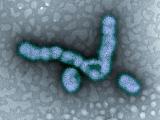Apr 28, 2009 (CIDRAP News) – As the official count of US swine influenza cases rose to 64 today, top federal health officials said it's becoming increasingly clear that the virus is spreading beyond people who recently traveled to Mexico, the epicenter of the outbreak.
"The information we're seeing from states and locals . . . is that this appears to be acting like a normal flu virus, which has a fairly high rate of transmission in families," Dr. Richard Besser, acting director of the Centers for Disease Control and Prevention (CDC), said at a news briefing this afternoon. He said investigators are finding respiratory and flu-like illnesses in family members of case-patients.
Besser said the only confirmed case of person-to-person transmission in the United States so far is in the two Kansas cases, which officials have said involved a husband and wife. But he said that probably only reflects the limited extent of testing, adding, "I expect we are seeing transmission within families."
Later he commented that while travel history is an important diagnostic clue in people who have a flu-like illness, "I wouldn't limit it to that, because it's really [in] a minority of cases to date that we've identified that travel history."
The signs of ongoing transmission seem to fit with the World Health Organization's (WHO's) move yesterday to raise the pandemic alert level to phase 4, which means a new flu virus can spread efficiently enough to cause sustained community outbreaks.
This morning the CDC raised its case count to 64, from 40 as of yesterday, including 45 cases in New York, 10 in California, 6 in Texas, 2 in Kansas, and 1 in Ohio. Besser said five patients have been hospitalized—three in California and two in New York—but provided no details on their illnesses.
The Associated Press reported this afternoon that "several hundred" students who attend a New York City Catholic school that has been hit by swine flu are sick.
Besser reported that the latest illness onset date in a confirmed swine flu case is Apr 24, but that doesn't mean there has been no transmission since then.
"We're asking that if you are a confirmed case not only that you stay home, but that the rest of your family stay home as well," to limit the virus's spread, he said.
States all want supplies
In other comments, Besser reported that all states have now requested their shares of antiviral drugs and personal protective equipment from the Strategic National Stockpile, and the CDC is working to fulfill the requests. He called the requests "a forward-leaning step," since most states don't have any cases yet.
In response to a question, he said the CDC has not yet identified anything that distinguishes swine flu from seasonal flu, aside from the possible clue of a travel history. He said it was an advantage that the new virus did not emerge in the middle of the regular flu season.
"If this outbreak had occurred in January or February it would've been very difficult to detect because of all the flu activity going on," he said.
On vaccine issues, Besser called the possibility of adding a swine flu antigen to the seasonal flu vaccine "an attractive approach" in that one vaccine could protect against seasonal and swine flu infections. "We do know that seasonal flu vaccine production is moving forward, and we don't want to delay that, but that is under consideration," he added.
The other possibility is to make a monovalent vaccine, containing just the swine flu strain, he noted.
The CDC previously said it was developing a seed strain of swine flu virus for companies to use in making a vaccine. Besser said the seed strain has not yet been sent to the manufacturers.
He also reported that the incubation period in US swine flu cases appears to range from 2 to 7 days, which he termed typical for flu.
Earlier in the day, Dr. Keiji Fukuda of the WHO emphasized—as he did yesterday—that the swine flu represents "a serious situation" but that a pandemic is not yet inevitable. "We really are in a period in which countries should take this opportunity to really prepare themselves for the possibility of a pandemic," especially countries not yet dealing with cases, he said.
He said that as of today the WHO officially counted 79 cases, including 40 in the United States (the number reported yesterday), 26 in Mexico, 6 in Canada, 3 in New Zealand, 2 in Spain, and 2 in the United Kingdom.
Later today, the WHO in an online statement reported that Israel has confirmed 2 cases. The numbers are confirmed cases reported by governments.
Fukuda, the WHO's assistant director-general for health security and the environment, stressed how much remains unknown about the new virus, including where it originated and why severe cases seem to be confined to Mexico.
"We still do not have a good explanation for why the pattern of cases in other countries appears relatively mild while the pattern in Mexico appears to be much more severe," he said. Besser said much the same in the CDC briefing.
When asked about reports that the virus might have originated in Mexico's Vera Cruz state, Fukuda said, "I think right now it's not possible to really know where this virus originated." He added that the swine flu isolates that have been analyzed have been very similar, suggesting that the virus emerged recently and has not been around long enough to branch into many variants.
Fukuda cautioned that even if swine flu activity subsides sometime soon, it will be at least several months before experts can conclude that a pandemic won't happen. "It's very hard to know when something like this disappears. I don't think we'll be able to conclude that in the next few weeks."
He also warned not to forget how the great pandemic of 1918-19 unfolded. "It also started out as a relatively mild spread of illness that really wasn't much noted in most places, but then it became a very severe pandemic in the fall," he said.
See also:
CDC swine flu page
http://www.cdc.gov/swineflu/
Apr 28 WHO update
http://www.who.int/csr/don/2009_04_28/en/index.html
WHO swine flu page
http://www.who.int/csr/disease/swineflu/en/index.html



















